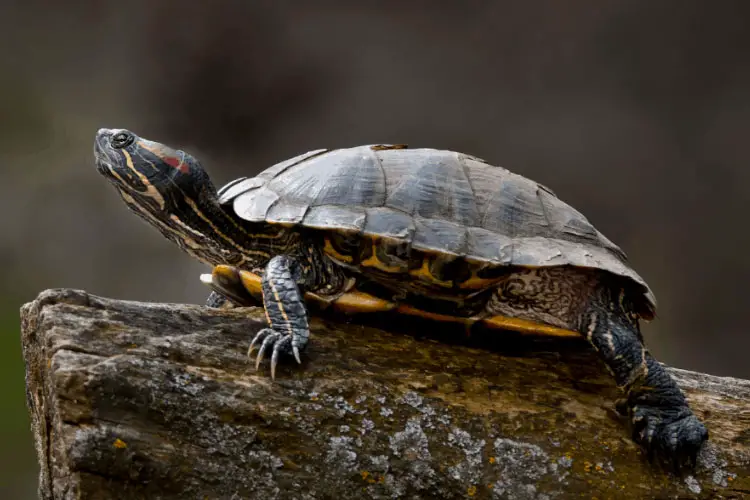Why Is My Turtle Shell Soft And What To Do About It?
The shell of a turtle should be naturally hard and smooth. Your turtle’s shell turning soft shell isn’t something you should take lightly. So, what could be the meaning behind the softened shell?
Why is my turtle shell soft? Your turtle shell is soft because the turtle could be suffering from a metabolic bone disease (MBD), which is caused by calcium deficiency. The shell could also go soft due to shell rot. This occurs when the shell gets damaged and weakened due to an infection, especially bacterial infections.
In the following guide, we shed more light on why your turtle shell has softened, what you can do to fix this problem, and preventive measures you can take to ensure it doesn’t happen in the future.
Why is my turtle shell soft?
Contents
As we just said above, metabolic bone disease (MBD), also known as soft shell syndrome, and shell rot are the two main culprits behind shell softening in your pet turtles. But that’s not all.
Below, we dig into more intricate details on what exactly leads to these conditions and ultimately leaves your turtle’s shell soft.
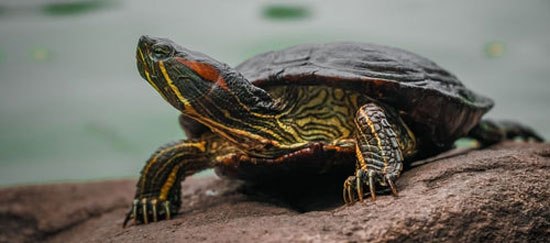
Here are the possible causes for a soft shell in turtles:
Calcium deficiency
Failure to include the right amounts of minerals, particularly calcium, in the diet of your turtle will result in MBD. When this disease kicks in, your pet’s shell becomes weak and soft. It may also start rotting and get highly vulnerable to severe infections.
Most pet owners think that commercial turtle pellets are enough for feeding their pets. But they lack essential nutrients and can deprive your turtle of vitamins and minerals they need to maintain a healthy exoskeleton. Try including calcium stone supplements in your turtle’s diet to quickly increase their calcium dose.
Insufficient lighting
If you have studied your pet turtles for a long time, then you already that they love basking. A daily dose of sunlight enables them to absorb the much-needed vitamin D3. This is responsible for healthy bone and sturdy shell growth.
What if natural sunlight isn’t available in your area? In that case, consider setting a UVB light near their tank.
Poor lighting will cause a soft shell that can lead to health complications in your pet. If you notice white parts on your turtle’s shell, it means they’re not receiving enough light and you should act accordingly.
Nutrients deficiency
Besides calcium, a lack of other essential nutrients that promote healthy growth in your turtle may also cause its shell to go soft.
Most turtle species are omnivorous and you can feed them chunks of cooked meat, protein pellets, insects, fruits, and veggies.
Genetic and environmental factors may make your turtle lack these nutrients. if this happens, it can deteriorate their health, and soft skin may show up sooner or later.
Infection
Bacteria or fungal infections may also be the culprit behind your turtle’s softened skin. This can appear in form of shell rot; a severe condition that involves an ulcer or infection forming anywhere on your turtle’s shell.
Shell rot can also arise from parasite infections. Even internal parasites like gastrointestinal parasites can harm your turtle’s shell health, ultimately leading to soft shell syndrome.
How to determine the cause of soft shell in your turtle?
Uncovering the cause of your softened turtle shell is important to help you decide the right treatment for your pet. It also helps you determine whether you need to change your pet’s diet or living conditions to prevent this health issue from happening again in the future.
Unfortunately, your turtle, like all the other pets, will not communicate what’s ailing it. It is upon you to take care of their health and determine the cause of various health issues affecting them.
When you notice a change in the turtle shell’s health, we advise you to take your pet to the vet as soon as possible.
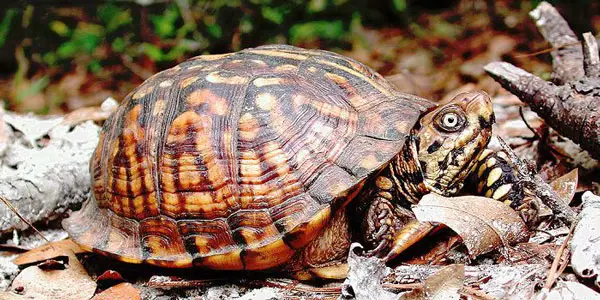
A professional vet will carry out a diagnosis to determine the exact cause of soft shell syndrome.
Sometimes, they may also carry out blood tests to uncover the exact course if your information doesn’t give any conclusive decision. A blood test will be particularly helpful in determining whether your turtle is under parasite infection.
If your turtle has a metabolic bone disease, the reptile vet will also be able to carry out a test to determine low calcium levels or insufficient vitamin D3 levels is the cause.
IMPORTANT: If shell rot or MDB goes unnoticed in your turtle, it may develop into more advanced stages, and reversing its effects will be too late!
How do you treat metabolic bone disease in turtles?
If you have confirmed that your turtle is suffering from MBD or soft shell syndrome, you need to take action ASAP! This disease can drastically affect your turtle’s health and well-being and even result in death if not treated in time.
To understand how to treat MBD in your turtle, you first need to understand that this disease is caused by a lack of calcium and insufficient lighting.
If caught early, MDB in turtles may be successfully alleviated by increasing their vitamin D3 and calcium levels in their diet. Giving them a dietary supplement, e.g. phosphorus-free calcium powder can help in this case.
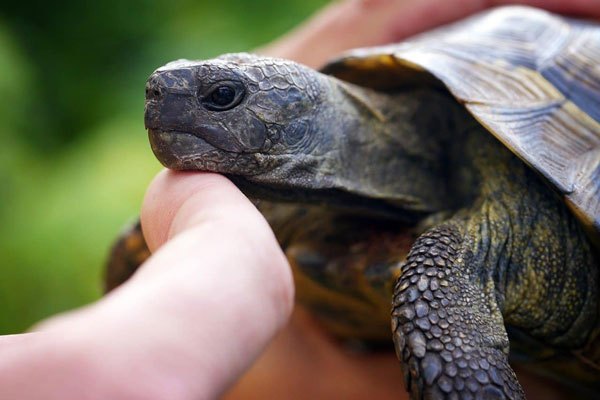
Besides, you should also analyze what foods you feed your turtle. Some foods may lack essential vitamins and nutrients. Others may be healthy but contain compounds, e.g. oxalates, which inhibit calcium absorption in the turtle’s body.
Get rid of foods that contain no nutritional value for your turtle such as iceberg lettuce.
And don’t forget to expose your turtle friend to adequate UV rays as another effective way of treating MDB when in its early stages.
NOTE: If supplementing your turtle’s diet and following the other care tips above don’t seem to work for fixing your turtle’s soft shell condition, visit your vet for a professional diagnosis of MDB and treatment.
How to prevent soft shell in your turtle?
You can prevent soft shell in your turtle by ensuring your pet enjoy enough calcium and phosphorus in its diet and gets sufficient exposure to light. Consider supplementation of minerals such as calcium if necessary.
If your turtle doesn’t bask frequently, provide it with a basking platform to facilitate more frequent basking and enhance the absorption of UVB light. Adequate amounts of light will ensure your turtle takes in proper minerals, stay healthy, and develop a hard shell.
If possible, create a dedicated basking platform to help your turtle bask regularly.
You should also provide the pet with a healthy, balanced diet that includes meat, fruits, and veggies. Adding calcium and phosphorus to your turtle diet is also recommended.
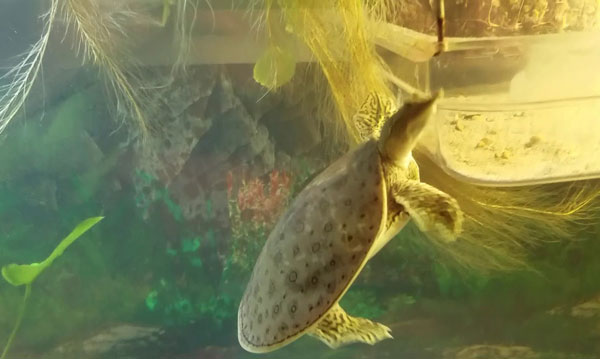
Another way to keep your pet’s shell healthy is by ensuring their living conditions are ideal. make sure the tank temperature stays between 75-86 degrees Fahrenheit at all times.
As for the air temperature, make sure it stays at around 109 degrees warmer compared to that of water. Use a thermometer to help you easily monitor your turtle’s habitat temperatures.
Proper living conditions for your turtle will prevent infections that can lead to soft shell problems. Provide them with fresh water, food, and bedding. Remove any uneaten water and food pieces to keep away molds that can lead to infections in your pet.
Regularly health-check your turtle for any health complications. Whenever you notice weight loss in your turtle, we also advise you to take action as soon as possible. This is because soft shell in turtles is usually accompanied by weight loss.
Why is my baby turtles shell soft?
Baby turtles generally have softer shells compared to their adult counterparts. Their shells can take years to form into perfectly hard shells.
Baby turtle shaving soft shells is generally not an issue. just keep taking good care of your young pet by feeding her with the right nutrition, giving her sufficient light exposure, keeping the environment clean, etc.—all these will help them develop a hard shell over time.
That said, these young turtles aren’t safe from MBD or shell rot. If your turtle has a too soft shell, then it is likely it could also be suffering from metabolic bone disease or it has an infection that has weakened/damaged its shell due to poor living conditions.
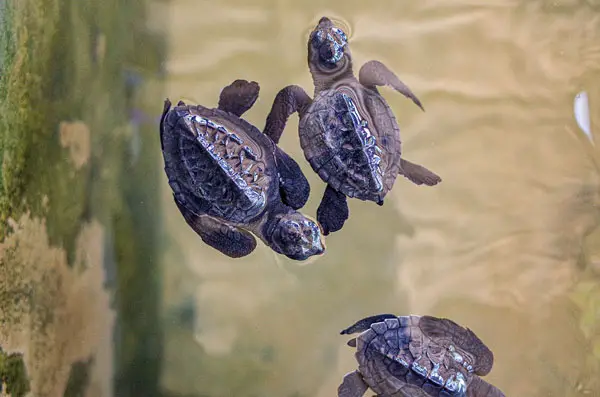
Softshell in young turtles is a serious health issue that can even lead to death. This is especially the case for aquatic turtles.
Luckily, you can still try to save your turtle by fixing the softened shell if you detect it in the early stages.
But the ultimate best way to save your turtle is to prevent the shell from softening in the first by feeding them the right amounts of calcium in their diet and ensuring they get adequate UV-B light exposure.
Keeping their habitat clean at all times will also help prevent infections that lead to shell rot.
Related questions (FAQs):
You can fix a soft turtle shell by ensuring they receive sufficient amounts of calcium in their diet. Give mineral supplements (calcium enhancers) to quickly increase their calcium.
Additionally, ensure they enjoy sufficient light exposure to help them absorb as much vitamin D3 as possible.
Other ways to fix the soft shell problem in your turtle is to feed them a healthy, balanced diet and keeping their habitat clean with stable living conditions.
Your red-eared slider turtle has a soft shell due to metabolic bone disease caused by a calcium deficiency or insufficient sunlight exposure.
If not detected early, this health issue can turn fatal and severely affect your turtle’s health. Follow the tips we have shared in the above guide to help prevent this from happening in future.
Final Verdict
A healthy turtle shell should have a hard and smooth shell. When your turtle’s shell turns soft, you should be worried because it might be suffering from metabolism bone disease or shell rot. The MBD disease is caused by calcium deficiency and insufficient exposure to UVB light while the rot can be due to an underlying fungal or bacterial infection.
Feeding your turtle with the right amounts of calcium in their diet and exposing them to adequate UV lighting will help keep their shell smooth and prevent other severe health problems. Keeping their living conditions clean and ideal temperature conditions will further ensure their shell stay healthy.


